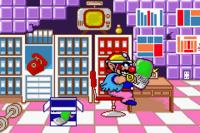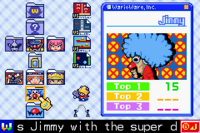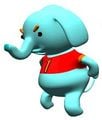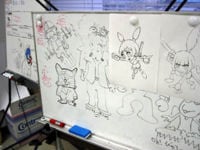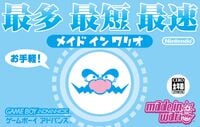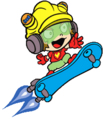WarioWare, Inc.: Mega Microgame$!
| WarioWare, Inc.: Mega Microgame$! | |||||||||||
|---|---|---|---|---|---|---|---|---|---|---|---|
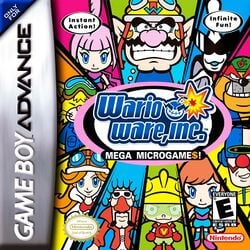 North American box art For alternate box art, see the game's gallery. | |||||||||||
| Developer | Nintendo R&D1[1] | ||||||||||
| Publisher | Nintendo | ||||||||||
| Platform(s) | Game Boy Advance, Virtual Console (3DS, Wii U), Game Boy Advance - Nintendo Switch Online | ||||||||||
| Release date | Game Boy Advance: Template:ReleaseVirtual Console (3DS) (Ambassador Program Release): Template:ReleaseVirtual Console (Wii U): Template:ReleaseGame Boy Advance - Nintendo Switch Online: Template:Release[?] | ||||||||||
| Language(s) | English (United States) French (France) German Spanish (Spain) Italian Japanese Simplified Chinese | ||||||||||
| Genre | Action | ||||||||||
| Rating(s) | Game Boy Advance:
| ||||||||||
| Mode(s) | Single-player, 2 players simultaneous (four minigames) | ||||||||||
| Input | Wii U: Nintendo Switch: Game Boy Advance: Nintendo 3DS:
| ||||||||||
WarioWare, Inc.: Mega Microgame$!, known as WarioWare, Inc.: Minigame Mania in European languages and known as Made in Wario in Japanese, is a minigame compilation for the Game Boy Advance and the first title in the WarioWare series of games. It was released on March 21, 2003 in Japan; later that year in Europe, the Americas, and Australia; and on July 4, 2005 in China. The game has the player play through themed gauntlets of microgames, which are very short and simple minigames that only last for a few seconds each; the player must understand the goal of each microgame within this time, through a short written command and contextual clues. The game's plot centers around Wario, who founds a game company and creates a video game along with his friends, an entirely new cast of characters who reside in Diamond City. Some of the game's music and sound effects are taken from Wario Land 4.
Based on the "Sound Bomber" mode of Mario Artist: Polygon Studio, Mega Microgame$! was a passion project for its development team, who developed it in secret before showing it to their producers. The game was praised by critics for its innovative concept and addictive nature, and would become a commercial success despite low internal expectations, selling over one million units worldwide.
It was re-released as a free downloadable title for the 3DS Ambassador Program in December 2011, only available to people who purchased a 3DS before the August 12, 2011 price drop. The game was also released on Wii U's Virtual Console in the Americas, Europe, and Australia on April 10, 2014, and for Game Boy Advance - Nintendo Switch Online as one of the application's launch titles on February 8, 2023.
The Nintendo 3DS release requires 78 blocks (9.9 MB) of memory to be installed.
64 of its microgames eventually made it to WarioWare Gold on the Nintendo 3DS in 2018.
Story
One day, while lounging on the couch in his house in Diamond City, Wario sees a report from Ken the Reporter on TV about a video game called Pyoro that made tons of money. Wario thinks of all of the cash that he could get if he made a video game, and quickly sets out on his bike to obtain a computer. Wario's house then gets renovated into the headquarters of WarioWare, Inc., Wario's newly founded company. After trying to make a video game by himself, Wario grows lazy and calls up his closest friends to help; they agree.
At the end of the game, WarioWare, Inc.'s game becomes a commercial success. Wario ends up swindling his employees, though, refusing to pay them and taking all of the money for himself. In the WarioWare, Inc. headquarters, he runs away from his friends with the cash and escapes with a rocket attached to the building. However, Dr. Crygor, swimming in mid-air, accidentally bumps the rocket, causing it, Wario, Dr. Crygor, and the banknotes to all fall into the sea, with the rest of the employees watching from the harbor.
Gameplay
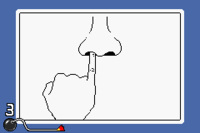
The game is based around the concept of playing very quick, simple microgames (over 200 in all) in rapid succession. Most games only last about four seconds on the lowest speed. There is a wide range of microgames, each of which vary heavily in art style and gameplay; some games feature simple stick figures against solid-color backdrops, some games show photographs, and some games are based on classic video games. A microgame makes use of either the ![]() Control Pad, the
Control Pad, the ![]() button, or both, depending on the task it gives the player. Shortly before a game starts, simple instructions such as "Dodge!", "Pick!", or "Catch!" are displayed. Each microgame features three difficulty levels. Depending on the game mode, the difficulty of microgames being played may ascend from the lowest to the highest difficulty level.
button, or both, depending on the task it gives the player. Shortly before a game starts, simple instructions such as "Dodge!", "Pick!", or "Catch!" are displayed. Each microgame features three difficulty levels. Depending on the game mode, the difficulty of microgames being played may ascend from the lowest to the highest difficulty level.
The game's main progression takes place in the stages of the Games mode, hosted by Wario and his friends. After beating a certain number of the microgames in a stage, the speed of the microgames, and occasionally their difficulty, increases. The microgames appear in a mostly random order. In addition, there is also an arcade-style mode known as Grid mode, where the player aims for a high score in a single microgame, which cycles through its difficulty levels before speeding up. This concept was first used in Mario Artist: Polygon Studio in the Sound Bomber mode, albeit in a much simpler form with only eight microgames in total.
Games mode
Microgame stages
The Games mode serves as the game's main campaign. There are nine stages hosted by the different characters from the game. Each character has their own set of microgames based around a certain theme, in addition to two special stages that are composed of microgames from several previous sets. Each of the eleven stages must be beaten to progress through the story. All stages feature prologue and epilogue cutscenes focusing on their respective character, which are viewed before and after the actual gameplay.
To beat a given set, the player must beat a specific number of the microgames specific to that set without getting a Game Over. The last game in a given set is the boss stage, a more complex game that lacks a time limit. Players are given four lives, losing one for every microgame lost. Losing all lives results in a Game Over. Between every microgame, a short intermission displaying the current score and number of lives shows up, with its appearance being based on the character's story. Seeing a microgame in the Games mode unlocks it for free play in the Grid mode.
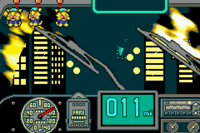
After beating a stage, a player can replay it indefinitely to obtain a high score. The player scores a point after every microgame, even if they lost the game, as long as they have at least one life remaining afterwards. In this challenge, the game continues after every boss stage on a higher difficulty level. After beating the boss stage on the third level and every subsequent time, the speed increases additionally instead. By winning a boss stage, the player also gains an extra life if they have less than four lives. In addition, after a boss microgame, a short break scene featuring the stage's host is shown, which the player can influence by pressing the ![]() button. Each stage only needs to be played once to reach the epilogue cutscene at the end of the game, but some extra content is only unlockable by getting a minimum high score on certain stages, and playing every microgame at least once is required to unlock two of the bonus minigames.
button. Each stage only needs to be played once to reach the epilogue cutscene at the end of the game, but some extra content is only unlockable by getting a minimum high score on certain stages, and playing every microgame at least once is required to unlock two of the bonus minigames.
Extra content
By playing the stages, extra challenges can be unlocked. These include special minigames for one or two players, as well as mixes of the microgames from all sets. They are chosen from the same screen as the microgame stages in Games mode.
The single-player challenges feature special minigames, several of them being extended versions of certain microgames. There are also four 2-player minigames, which use the ![]() and
and ![]() buttons to allow two players to play using only one handheld. A single bonus minigame can only be unlocked by playing the microgames in the Grid, rather than the stages.
buttons to allow two players to play using only one handheld. A single bonus minigame can only be unlocked by playing the microgames in the Grid, rather than the stages.
In addition, there are four tower stages that are unlocked after completing the game, which challenge the player to beat as many microgames as possible until all lives are lost. Microgames from all previous stages are put into the mix, with various additional rules applied for each. For example, one tower challenges players to not lose a single life while playing microgames at their hardest difficulty.
Grid mode
In this mode, players can play any microgame they have previously encountered in the Games mode. When a microgame is selected in the Grid mode, a single challenge is repeated endlessly in an arcade-style format until they lose the microgame four times. Like in the stages, the player scores a point after every playthrough. The game cycles through each of the three difficulties the microgame has, with the first one being easy, the next being of normal difficulty, and the third being hard. After that, the speed of the game increases, and the game returns to its easiest difficulty, starting the difficulty cycle again. Each microgame has a designated score to beat, ranging between 10 and 30 points for regular games, and 5 for boss games. Upon meeting this score, the microgame is marked with a red flower.
Options
In the Options menu, the player can view the epilogue cutscenes after clearing the Games mode sets, as well as tweak settings related to their save file, from changing the player name and gender to erasing the save file's contents. The player's name and gender only change some scenes in the character stories and lines of text, without affecting gameplay. In addition, on the name change screen, the player can change the background music by pressing the ![]() button; the songs available are "Drifting Away", "Four Seasons", and "Dr. Crygor's Bathroom Jam".
button; the songs available are "Drifting Away", "Four Seasons", and "Dr. Crygor's Bathroom Jam".
Characters
Main characters
Aside from Wario himself, WarioWare, Inc.: Mega Microgame$! introduces a completely new cast of characters in the form of Wario's friends and the other citizens of Diamond City, a location which also debuted in this game. Each of the main characters host a set of microgames, and come with an individual story dedicated to them in the form of a prologue and epilogue. At the end of every story after the Introduction, the respective character meets with the other ones at the Gelateria. The characters were designed by Ko Takeuchi.[2]
| Image | Name | Description |
|---|---|---|

|
Wario | "Its-a me, Wario! Yeah, yeah, I'm the bad guy... but this time, I came up with a legit way to make fistfuls of cash using my superior intellect! That's right! I'm not cheating-this time, anyway! Listen, will ya?! I've created a software company to make the best, most interesting games the world has ever seen! And it's going to make me filthy rich! Wah, ha, ha, ha!" |
| Wario's first story: Wario is seen exercising in the WarioWare, Inc. headquarters. He promptly leaps into a boombox from up high and appears on the monitor, kickstarting the microgames. In the epilogue, a shrunken Wario emerges from the boombox, alongside a few vehicles from the microgame "Crazy Cars". After dodging them, Wario re-enters the boombox before re-emerging at his normal size and promptly flattening the cars. Wario laughs, and his story ends. Wario's second story: | ||

|
Jimmy T. | "Hey, hey! It's Jimmy T.! Big moves, bigger wigs, and only the biggest sports games! To boogie with me, you've gotta send me cell-mail. And you? You say that you and Wario are really tight? That's cool! C'mon, let's hit my favorite disco and get funky 'til dawn! I know Wario looks offbeat, but he and I go way back. Plus, he always sends me cell-mail!" |
| Jimmy T.'s story: Jimmy T. goes to Club Sugar at night to start dancing, before pulling out his cell phone, which begins receiving incoming messages. In the epilogue, he leaves Club Sugar, and hears a ring tone on his phone while strolling through the city. | ||

|
Dribble & Spitz | "I'm Dribble. This is my pal Spitz. Together, we make one crash-bang cabbie team! When Wario asked us to team up and make some hard-drivin' sci-fi game, we couldn't say no! Hop in our cab and try-em out! We'll cut you a deal on the fare! Oh, hey! Between us, we taught Wario how to drive! He'd never admit it, but it's true..." |
| Dribble & Spitz's story: At night, Dribble & Spitz are driving with the taxicab through the city and get a customer who is named after the player, who requests to go to the city's harbor. In the epilogue, they arrive at the harbor, and the customer leaves the taxi and transforms into a merperson. They jump into the water and bid Dribble & Spitz farewell. When the person has already disappeared, Dribble & Spitz notice that the customer did not pay their fare. | ||

|
Mona | "Hey, you're a new face around here! Well, I'm Mona! I scoop gelato at the Gelateria—when I'm not at school or making games, that is. So anyway, you should know that that fortune-hunter Wario has inspired many of my strange games! He's always one degree ahead of cool, and he's even let me tag along with him on some of his money-grubbing adventures!" |
| Mona's story: Mona is driving to her workplace, the Gelateria, when she gets caught up by a long line of children. In an attempt to make it to work on time, Mona begins speeding; however, the Diamond Police notices her and begins chasing. Mona calls her three animals for help, the Elephant, Piggy and Chimp. One by one, they start to put the police cars out of action, and the player takes control of her Chimp, who has to aim at cars to slow them down with his banana peels. In the Epilogue, Mona arrives at the Gelateria and clocks into work at the last second. | ||

|
9-Volt | "Hey! My name is 9-Volt! I'm the grade-schooler gone old school! I've put together a collection of retro classics that'll make you late for class. Come on over and try a few out! I'll spin the tunes while you play the games! I think Nintendo games are the greatest, so you can imagine my surprise when I found out that Wario lives in my... uh, I mean that I live in his city!" |
| 9-Volt's story: After school ends, 9-Volt goes home on his skateboard. Once he arrives at home, 9-Volt spins records in his room, and begins remixing a new song. An oversized Game Boy next to 9-Volt uses a contraption to insert a cartridge into itself, starting a game modeled after a turn-based role-playing game, where the player encounters the microgames as battles. In the epilogue, Ken the Reporter suddenly appears and announces that the Game Boy Advance SP is on sale now. Excited by this, 9-Volt leaves the house, his skateboard transforms into a hoverboard, and he rushes off before later showing up at the Gelateria. | ||

|
Orbulon | "Hello, I'm the outer space life-form known as Orbulon. It might be hard to believe, but my carbon matter will turn 2000 years old this year! My fun units test the limits of your brain matter with challenging IQ games. You know, my propulsion transport device crashed into Wario's house on a previous visit. Since then, he allows me to crash there whenever I want!" |
| Orbulon's story: Orbulon is headed toward Diamond City's planet with his UFO, when a meteoroid flies right into the spaceship and damages it. Orbulon sends a distress call, and a rescue team of Space Hares appears. They send a container connected with a chain into the UFO, which Orbulon enters. In the epilogue, the Space Hares finally retract the chain, but as soon as Orbulon arrives in the rescue ship, he attempts to use his alien powers. Before he can do this, the Space Hares immediately reject Orbulon back to the Porker, which has since disentangled itself from the meteor. Spinning out of control, Orbulon and his ship make a crash-landing by the Gelateria. | ||

|
Dr. Crygor | "I am Dr. Crygor, the genius scholar. Others have said a "dangerous" scholar, but I pay no mind to their opinions. My laboratory is set up to further my experiments in reality games. Feel free to stop by and contribute to my research. It is quite fun. Did you know that I was the one who created Wario's car? What? You do not know? Do your research!" |
| Dr. Crygor's story: Dr. Crygor is mixing chemicals in his laboratory, and then reaches for something to drink. Without looking, he grabs a beaker filled with a blue liquid, and drinks it. When his stomach starts cramping, Dr. Crygor runs for the restroom and opens the toilet lid. In the epilogue, after he has done his business, the toilet suddenly erupts a jet of water and begins to flood the lab. While Dr. Crygor tries to swim away, he is instead sent rocketing into the sky and is sent plummeting down. Luckily, Don the Sparrow catches and rescues Dr. Crygor. | ||
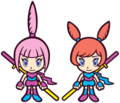
|
Kat & Ana | "We're Kat and Ana! Yep, we're cute, we're kindergartners, and we're ninjas! We like plants and animals so much that we included them in our games. Apparently, we are graduates of Wario's school of Kindergarten—at least, that's what the graffiti on the wall said! If I remember, the teachers weren't too happy about that..." |
| Kat & Ana's story: An evil skeleton spirit named Boneheads appears at the Castle, and curses a prince or princess named after the player before taking over the Castle. Ana and her crew of ninjas attack Boneheads, but they all fail. Ana quickly sends a letter with the help of Don the Sparrow to her sister Kat to call for help, before being captured by Boneheads. Kat, residing with Paw the Dog at a place far away, then receive the letter, and her and Paw make the long journey to the castle, where Kat has to fight Boneheads atop the roof. In the epilogue, Kat duels Boneheads, and almost loses, before Paw transforms into a giant sword. With this weapon, Kat manages to destroy Boneheads and saves Ana and the royal. | ||
Other characters
Games
Microgames
- Main article: List of WarioWare, Inc.: Mega Microgame$! microgames
There are nine different sets of microgames, each one created by one or two WarioWare developers and focused on a certain theme.
| Genre | Developer | Description |
|---|---|---|
Intro Games |
Introduction
|
Games that all involve Wario in some way. The set only features 12 normal microgames. |
Sports |
Jimmy
|
Games that feature a certain sport, such as baseball and tennis. |
Sci-Fi |
Dribble & Spitz
|
Games which focus on science fiction elements, such as aliens, space fights, and superheroes. |
Strange |
Mona
|
Games which present realistic tasks, such as nose-picking and sawing, in a strange way. |
Nintendo Classics |
9-Volt
|
Games which are based on classic Nintendo games and toys, such as Super Mario Bros. and the Ultra Hand. |
IQ |
Orbulon
|
Games that last twice as long as usual, due to involving tasks that require more thinking than other microgames, such as counting and finding an object on the screen. |
Reality |
Dr. Crygor
|
Games which feature partly animated photographs, such as photos of people and animals. |
Nature |
Kat & Ana
|
Games that involve animals or plants, such as frogs and flowers. |
Anything Goes |
Wario
|
Games that all overtly feature Wario, with no other specific theme. Some microgames in this set are parodies of other Nintendo games. |
Microgame set compilations
Besides the single sets, there are also six extra microgame stages involving the microgames from more than one character. Two of them are remixes of Jimmy T.'s set, which act much like the regular stages and need to be beaten to unlock either three new stages or a single new stage, respectively. The other ones are hosted at four different towers located in Diamond City, all featuring pig sculptures. The intermission between the microgames in the tower stages looks like a child's drawing of the inside of an elevator, with inverted colors and an animated pig head on the doors.
| Name | How to unlock | Description |
|---|---|---|

|
Beating Dribble's, Mona's, and 9-Volt's stages | A mix of the microgames of Jimmy and the aforementioned characters. However, Jimmy's boss stage, "Punch Out" (which starts at level 2), is the only boss stage to appear. The games also start on the normal difficulty level. |

|
Beating Orbulon's, Dr. Crygor's, and Kat's stages | A mix of the microgames of the aforementioned characters. Again, only Jimmy's boss stage is featured (which is always on the hardest level), and the games start on the normal difficulty level. |

|
Beating Wario's second stage | The microgames of all characters on the lowest difficulty level randomly appear. No boss microgames appear, meaning that no extra lives can be earned. The speed is at its default, and never speeds up. |

|
Beating Wario's second stage | Only the boss stages appear in this stage, in a constant order and at a high speed. After beating Wario's Adventure, it starts at the first again, and the difficulty level increases like in normal microgame stages. If the player fails a boss microgame, they must redo that microgame again until they pass it. Extra lives cannot be earned. |

|
Scoring 15 or more points in Easy | The speed is at its slowest, and never increases. However, all games are on the third difficulty level, and only one life is available, meaning that the game is over after only one lost microgame. Boss microgames are not included, and no extra lives can be gained. |

|
Scoring 15 or more points in Thrilling | All microgames are set at the lowest difficulty level, and no boss microgames appear, but all microgames are played at a high speed, and the player cannot gain any extra lives. |
Bonus minigames
Besides the microgames, minigames without a strict time limit can be unlocked. These mostly include expanded versions of the microgames, as well as ports of previously released Nintendo games, altered to include Wario and his friends. Some of these games also include other WarioWare developers than Wario.
Single player
In these games, the player aims for a high score, which are saved.
| Name | How to unlock | Description |
|---|---|---|

|
Beating Jimmy's stage. | Wario has to jump a rope. Its speed and position change during the game. Jump Forever ends the first time Wario's body touches the rope. If the player reaches 100 jumps, they unlock the option of being able to change the BGM when starting a new game. |

|
Beating Jimmy's Remix No. 1 stage. | 9-Volt has to avoid obstacles and birds with his skateboard by jumping and ducking. The game ends with one miss. |

|
Beating Jimmy's Remix No. 2 stage. | The player has to move a paper plane that glides downward through a tower, without touching any obstacles. |

|
Scoring 20 or more points in Jimmy's stage. | The Viruses have to be eradicated by placing the capsule segments of the same color in line with them. The speed and difficulty of the game can be changed at the start of the game, and both increase as the game continues. This minigame is a slightly altered port of the NES game Dr. Mario. |

|
Scoring 25 or more points in Jimmy's Remix 1 stage. | In each level, the player has to hit all of the insects and avoid their attacks; after this, King Watinga appears as the boss. This minigame is a altered port of the minigame Gnat Attack from the SNES game Mario Paint. The player moves with the |

|
Scoring 25 or more points in Jimmy's Remix 2 stage. | Betty has been kidnapped by bandits, and Wario has to rescue her by shooting all of the bandits in each level. This minigame is a slightly altered port of the arcade game Sheriff. |

|
Unlocking all games in the Grid. | A small bird named Pyoro must catch falling beans by extending his long tongue. The higher away the beans are, the more points they are worth. If a bean hits Pyoro, the game is over. |

|
Earning a flower in all games in the Grid. | Similar to the previous game, but instead of using his tongue, Pyoro spits seeds in front of him, which can destroy the vegetables. The player scores more points when two or more beans are hit at the same time. Again, the game ends as soon as Pyoro is hit by a bean. |
Two-player
In all of these games, one player has to press the ![]() button, while the other one has to press the
button, while the other one has to press the ![]() button. Unlike single-player games, there are no high scores, and the game ends after one player has earned the necessary points and won, with each game played in a best-three-out-of-five system.
button. Unlike single-player games, there are no high scores, and the game ends after one player has earned the necessary points and won, with each game played in a best-three-out-of-five system.
| Name | How to Unlock | Description |
|---|---|---|

|
Beating either Dribble & Spitz's, Mona's, or 9-Volt's stage. | The players move vacuum cleaners and have to pick up as much trash as possible. Based on the toy Chiritorie released by Nintendo in 1979. |

|
Beating one more of the stages named above. | Based on the game of Chicken. 9-Volt (P1) and Shag (P2) have to get as close to the edge as possible, but must not exceed it. |

|
Beating either Orbulon's, Dr. Crygor's, or Kat & Ana's stage. | Both characters, Mona (P1) and Dribble (P2), have their own side. The game's goal is to use the bar that moves up and down to push one of the yellow blocks to the other side, in order to squash the opponent. |

|
Beating one more of the stages named above. | Orbulon (P1) and Dr. Crygor (P2) take part in a hurdle race, where they have to jump hurdles and run on mud. |
Locations
Diamond City, the main place of the WarioWare series, features several locations in this game that are mostly connected to one character or character pair each.
Objects
The following list includes the objects mostly seen in the character-related cutscenes.
Development
WarioWare, Inc.: Mega Microgame$! was developed by Nintendo R&D1, and first announced in early 2003. It was directed by Hirofumi Matsuoka and produced by Takehiro Izushi. Other key developers include Goro Abe, Ko Takeuchi, and Kazuyoshi Osawa.
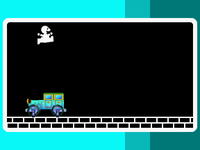
The WarioWare concept with very short minigames coming one after another was first used in Mario Artist: Polygon Studio, a game released for the Nintendo 64DD in 2000 only in Japan. The game's Sound Bomber mode includes eight microgames, and six of the microgames in WarioWare, Inc.: Mega Microgame$! are based on those.[3]
Made in Wario was originally made in secrecy by several developers on the development team Nintendo R&D1, without telling their manager at the time. The developers came up with the idea of using Wario for the game, as they could not think of anyone else who would be best for the game, and because according to them, Wario is "always doing stupid things" and is "really idiotic"; thus, they used him alongside other newly created characters.[4]
Proud of their work, the developers presented their idea to their manager at a certain point. He was reportedly unsurprised, and simply gave his approval of the project, so the team continued development.[4]
For the creation of the microgames, each person on the team would come up with their own ideas, which were then written down on notes and attached to the director's table. After this, the developers went through the ideas to decide which ones could be included in the final product. Since the game became well-known around the department, even employees who were not formally on the project started to submit their microgame ideas. Because each of the programmers created their own graphics during the development of the games, the art style also wound up being very different with each microgame.[4]
Shigeru Miyamoto put a lot of thought into how best to market the game. He wanted to show how its unusual playing style made it distinct from other games, in the way it could be simply picked up and enjoyed. Miyamoto gave the staff the approval to use the slogan "More! Shorter! Faster!" (最多 最短 最速 Saita Saitan Saisoku), which prominently appeared on the Japanese box art, even surpassing the actual game logo in terms of size.[5] The slogan was not used for the later Western packages, which depicted Wario and his friends, rather than just a portion of Wario's face as seen on the Japanese counterpart.
Made in Wario, or WarioWare as the franchise is called in international languages, was first announced by Nintendo in early January 2003[6] and originally released in March 2003 in Japan. Nintendo did not have very high commercial hopes for the game; however, the game's sales figures grew significantly more than expected, and the game gained a very good reputation.[5]
Since WarioWare, Inc.: Mega Microgame$! was commercially successful, Satoru Iwata, president of Nintendo, requested a remake of the original WarioWare, Inc. for the Nintendo GameCube that had to be finished "as soon as possible." The development resulted in the first sequel, WarioWare, Inc.: Mega Party Game$!, which focuses on multiplayer and was released in Japan only half a year after the first game.[7] It is also the first WarioWare game that was formally co-developed by Intelligent Systems.[8] More WarioWare sequels have followed since, which mostly make use of a new piece of Nintendo's hardware, resulting in WarioWare becoming one of Nintendo's headliner titles whenever they release new hardware.[2]
Pre-release and unused content
Within the game's files are a few unused microgames. One of them is based on the Family Computer game F-1 Race, likely meant to be used in the Nintendo Classic microgame set. The player must keep the racing car on the road without bumping into other cars until the timer runs out. Its command is "Continues running", which lacks the exclamation point present in the used microgames' commands. It shares its music with Munch a Bunch.
Critical reception
Critical reception of WarioWare, Inc. was positive. GameRankings' overall score for the game is 89%.[9] WarioWare, Inc. also won numerous awards.
The Japanese Famitsu magazine rated the game a score of 35 out of 40.[10] 1UP.com's Shane Bettenhausen rated the game 9.5/10 and enjoyed how fast-paced and frantic the game was. He also stated that playing the games was all it took to convince his friends of the game's value. Bettenhausen enjoyed the weirdness of the game, too.[11] Jeff Gerstmannf of GameSpot stated that the combination of minigames and pacing of puzzle games such as Tetris came together wonderfully. He rated the game a score of 9.1/10.[12] IGN's Craig Harris loved WarioWare and awarded it a score of 9/10. He stated that it did not matter that the main quest only took one or two hours. The additional replay value made up for it. He also cited the game's "pick up and play" qualities as reasons for his high score.[13]
| Reviews | |||
|---|---|---|---|
| Release | Reviewer, Publication | Score | Comment |
| Game Boy Advance | Benjamin Turner, Gamespy | 91/100 | "My first few hours with WarioWare were extremely fun, as I couldn't get enough of the game's distinct brand of inspired insanity. Once that initial novelty started to wear off, however, I lost a bit of the enjoyment. The core gameplay is still plenty strong, though, and I fully expect to be enjoying WarioWare for the foreseeable future. WarioWare, Inc.: Mega Microgame$ is the ultimate game for the attention span impaired; Luckily, it's a lot of fun for everyone else too. It's great to see such a bold, original product from the Nintendo of 2003; If it could just turn this into a trend, it'd go a long way toward restoring lost luster to Kyoto's number one video game company." |
| Game Boy Advance | Tom Bramwell, Eurogamer | 9/10 | "Unlike a lot of GBA games, Wario Ware overcomes its potential brevity with a meaty selection of bonus games, and offers so much in one package that it's always going to happily occupy that slot should you feel like slipping the GBA into your pocket as you slide out the door. It may contradict the relaxing weather we're enjoying at the moment, but we'd happily sweat our way through a T-shirt drawer if it meant the difference between sunburn and playing Wario Ware. If variety is the spice of life, then Wario Ware is the digital equivalent of Phall curry, burning the inside of your face [it'll be more than your face that's burning after a Phall! - rueful Ed] with its charm and originality, and deservedly severing a few crisp bank notes from your wallet in the process - even if it does still plunder the crevices of yesteryear for a lot of its gaming content. Buy it or we'll smack ya." |
| Game Boy Advance | Jeff Gerstmann, GameSpot | 9.1/10 | "While it can be said that the game isn't quite as exciting once you've seen every minigame it has to offer, the method that it brings the games to you stays fresh, and a bevy of unlockables--including full versions of Dr. Mario (renamed Dr. Wario here) and Nintendo's classic arcade game Sheriff--keep things moving along quite nicely. In the end, the game does have a lot of that Tetris-like appeal, making it something that you can play in short bursts and return to again and again, which is one of the most admirable qualities a portable game can have. Anyone looking for an exciting change of pace will have a fantastic time with WarioWare." |
| Aggregators | |||
| Compiler | Platform / Score | ||
| Metacritic | 89 | ||
| GameRankings | 88.83% | ||
Awards
The game was awarded the Editor's Choice Award at both GameSpot and IGN.[14][15] At the Edinburgh International Games Festival in 2004, WarioWare took the Edge Award, and was named the most innovative game of the year.[16] WarioWare, Inc. also gained one of the three Innovation awards at the 4th annual Game Developers Choice Awards in 2004.[17] In 2008, Game Informer named the game one of the top ten weirdest of all time.[18]
Staff
- Main article: List of WarioWare, Inc.: Mega Microgame$! staff
WarioWare, Inc.: Mega Microgame$! was entirely developed by Nintendo R&D1. The game was directed by Hirofumi Matsuoka, who previously directed Wario Land 4 and Mario Artist: Polygon Studio, the latter of which contained the "Sound Bomber" mode that served as a direct inspiration for WarioWare. WarioWare was Matsuoka's last work at Nintendo, as he would depart the company to join Creatures, Inc. shortly after the completion of the game.
Gallery
- For this subject's image gallery, see Gallery:WarioWare, Inc.: Mega Microgame$!
Jimmy T. with his cell phone
Media
- Main article: List of WarioWare, Inc.: Mega Microgame$! media
| File info |
| File info |
| File info |
| File info |
| File info |
| File info |
| File info |
| File info |
| File info |
| File info |
Names in other languages
| Language | Name | Meaning | Notes |
|---|---|---|---|
| Japanese | メイド イン ワリオ[?] Meido in Wario |
Made in Wario | |
| Chinese (simplified) | 瓦力欧制造[?] Wǎlì'ōu Zhìzào |
Made in Wario | |
| Chinese (traditional) | 瓦利歐製造[19] Wǎlì'ōu Zhìzào |
Made in Wario | |
| French (NOE) | WarioWare, Inc.: Mega Mini-jeux[?] | WarioWare, Inc.: Mega Mini-Games |
References
- ^ Nintendo R&D1 at IGN
- ^ a b Iwata Asks: Nintendo DSi: Big One-off Performance
- ^ Sound Bomber mode of Mario Artist: Polygon Studio at Kimahima.com (Japanese)
- ^ a b c Nintendo R&D1 Interview (page 2) at Kikizo
- ^ a b Iwata Asks: WarioWare: Smooth Moves: Everyone in the Room Will Have a Grin on Their Face!
- ^ Harris, Craig (January 7, 2003). New Mario and Wario GBA Games. IGN.
- ^ Iwata Asks - Volume 5: WarioWare Snapped! - Page 1
- ^ A list of Intelligent Systems' games at their official website
- ^ WarioWare, Inc.: Mega Microgame$! at GameRankings
- ^ Ratings for WarioWare, Inc.: Mega Microgame$! at Gamekult (French)
- ^ WarioWare, Inc.: Mega Microgame$! Review at 1UP.com
- ^ WarioWare, Inc.: Mega Microgame$! Review at GameSpot
- ^ WarioWare, Inc.: Mega Microgame$! Review at IGN
- ^ Editor's Choice Award at GameSpot
- ^ Editor's Choice Award at IGN
- ^ News "GameBoy mini-games take top prize" at BBC News
- ^ Archive of Innovation awards at Game Developers Choice Awards
- ^ "The Top 10 Weirdest Games of All Time", Game Informer 180 (April 2008)
- ^ 介紹Nintendo Switch Online的最新資訊!「Nintendo Switch Online」的新成員Game Boy及 「Nintendo Switch Online + 擴充包」的新成員Game Boy Advance現已登場。 Nintendo HK. Retrieved February 9, 2023.
External links
- Official European Website
- Official Japanese Website
- Official Chinese Website
- European manual (EN/DE/FR/ES/IT)
